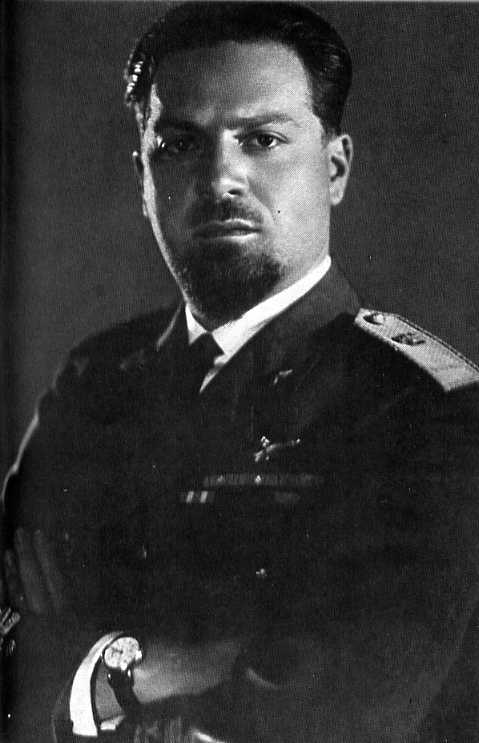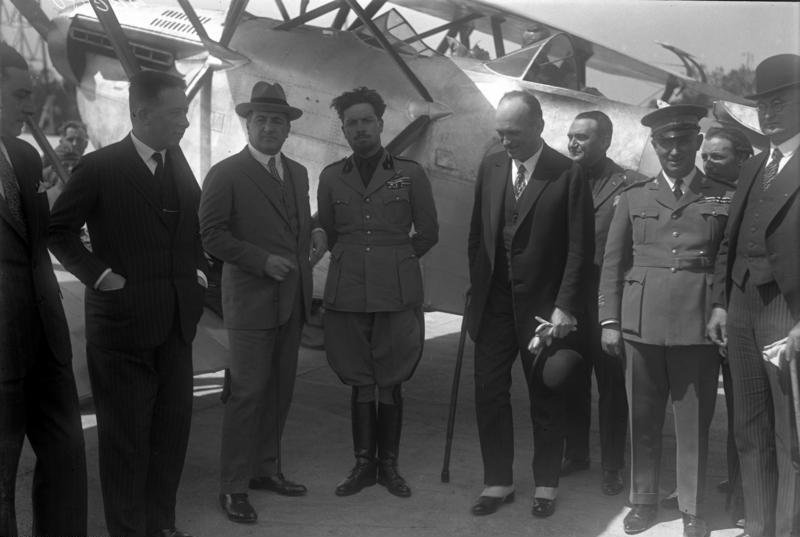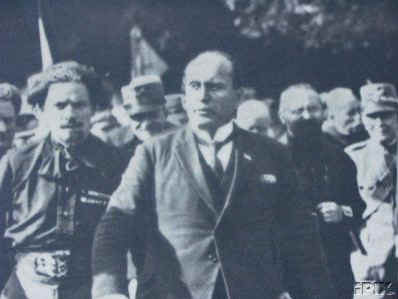<Back to Index>
- Mathematician Max August Zorn, 1906
- Sculptor Domenico Guidi, 1625
- Maresciallo dell' Aria Italo Balbo, 1896
PAGE SPONSOR
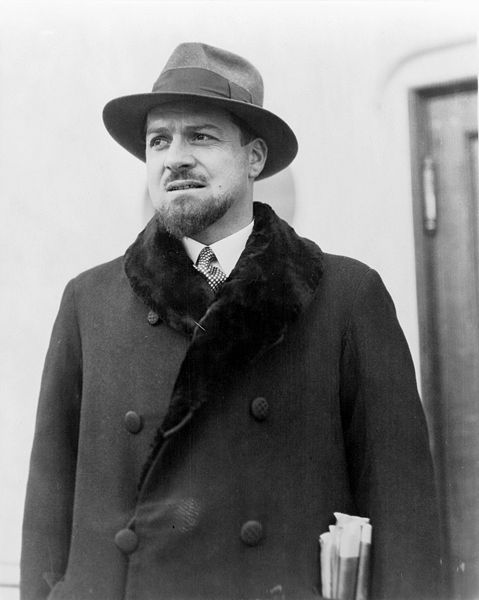
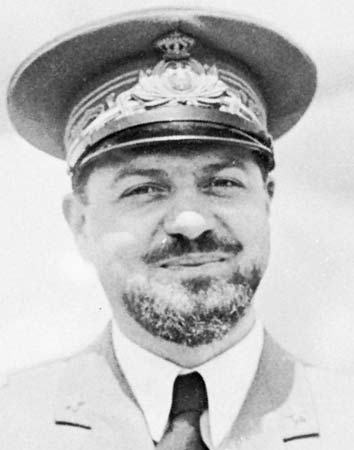
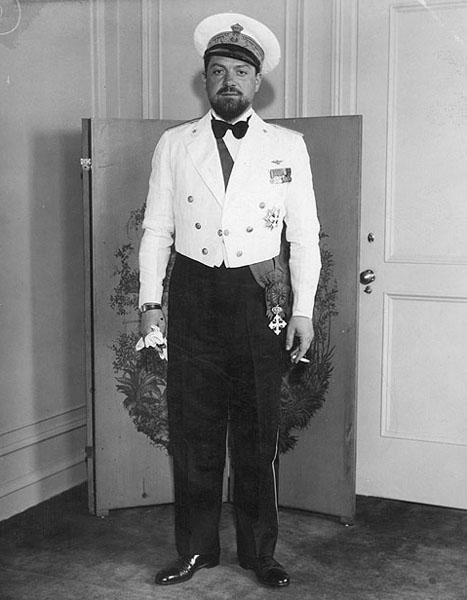
Italo Balbo (June 6, 1896, Ferrara – June 28, 1940) was an Italian Blackshirt (Camicie Nere, or CCNN) leader, Marshal of the Air Force (Maresciallo dell'Aria), Governor General of Libya, Commander-in-Chief of Italian North Africa (Africa Settentrionale Italiana, or ASI), and the "heir apparent" to Italian dictator Benito Mussolini. Balbo was killed when his plane was shot down over Tobruk by Italian anti-aircraft fire. The circumstances of his death are disputed.
In 1896, Balbo was born in Quartesana (part of Ferrara) in the Kingdom of Italy. Balbo was very politically active from an early age. At only 14 years of age, he joined in a revolt in Albania under Ricciotti Garibaldi, Giuseppe Garibaldi's son.
As World War I broke out and Italy declared its neutrality, Balbo supported joining the war on the side of the Allies. He joined in several pro-war rallies. Once Italy entered the war in 1915, Balbo joined the Italian Royal Army (Regio Esercito Italia) and served in the 8th Alpine (Alpini) Regiment. He earned one bronze and two silver medals and reached the rank of Captain (Capitano) due to courage under fire.
Just before the Italian defeat at Caporetto, Italo Balbo requested a transfer to the Italian Army Air Service (Corpo Aeronautico Militare). He apparently never quite began his flight training. Because of his sudden transfer before the disaster and because his battalion was captured at Caporetto, some accused Balbo of deserting.
In July and August 1918, Balbo returned to the 8th Alpine Regiment and again saw action in the war as a member of the Royal Army. He participated in the Battle of Vittorio Veneto. It was at this time that he earned his bronze and silver medals.
After the war, Balbo completed the studies he had begun in Florence in 1914 – 15. He obtained a law degree and a degree in Social Sciences. His final thesis was written on 'the economic and social thought of Giuseppe Mazzini' and he researched under the supervision of the patriotic historian Niccolò Rodolico. Balbo was a Republican but he hated Socialists and the unions and cooperatives associated with them.
Balbo returned to his home town to work as a bank clerk. In 1921, Balbo joined the newly created National Fascist Party (Partito Nazionale Fascista, or PNF) and soon became a secretary of the Ferrara Fascist organization. He began to organize Fascist gangs and formed his own group nicknamed Celibano, after their favorite drink. They broke strikes for local landowners and attacked communists and socialists in Portomaggiore, Ravenna, Modena, and Bologna. The group once raided the Estense Castle in Ferrara. Italo Balbo had become one of the "Ras," adopted from an Ethiopian title somewhat equivalent to a duke, of the Fascist hierarchy by 1922, establishing his local leadership in the party. The "Ras"
typically wished for a more decentralized Fascist Italian state to be
formed, against Mussolini's wishes. At 26 years of age, Balbo was the
youngest of the "Quadrumvirs": the four main planners of the "March on Rome." The "Quadrumvirs" were Michele Bianchi (age 39), Cesare Maria De Vecchi (38), Emilio De Bono (56),
and Balbo. Mussolini himself (39) would not participate in the risky
operation that would ultimately bring Italy under Fascist rule. In 1923, as one of the "Quadrumvirs," Balbo became a founding member of the Grand Council of Fascism (Gran Consiglio del Fascismo). This same year, he was charged with the murder of anti-Fascist parish priest Giuseppe Minzoni in Argenta. He fled to Rome and in 1924 became General Commander of the Fascist militia and undersecretary for National Economy in 1925. On 6 November 1926, though he had only a little experience in aviation, Balbo was appointed Secretary of State for Air. He went through a crash course of flying instruction and set up to build the Italian Royal Air Force (Regia Aeronautica Italiana). On 19 August 1928, he became General of the Air Force and on 12 September 1929 Minister of the Air Force. In Italy, this was a time of great interest in aviation. In 1925, Francesco de Pinedo flew a seaplane from Italy to Australia to Japan and back again to Italy. Mario De Bernardi successfully raced seaplanes internationally. In 1928, Arctic explorer Umberto Nobile piloted the Airship Italia on a polar expedition. Balbo himself led two transatlantic flights. The first was the 1930 flight of twelve Savoia - Marchetti S.55 flying boats from Orbetello, Italy, to Rio de Janeiro, Brazil, between
17 December 1930 and 15 January 1931. From 1 July – 12 August 1933, he
led a flight of twenty-four flying boats on a round trip flight from
Rome to the Century of Progress in Chicago, Illinois. The flight had seven legs; Orbetello — Amsterdam —Derry — Reykjavík — Cartwright, Labrador — Shediac— Montreal ending on Lake Michigan near Burnham Park. In honor of this feat, Mussolini donated a column from Ostia to the city of Chicago; it can still be seen along the Lakefront Trail, a little south of Soldier Field. Chicago renamed Seventh Street "Balbo Drive" and staged a parade in his honor. During Balbo's stay in the United States, President Franklin D. Roosevelt invited him to lunch and presented him with the Distinguished Flying Cross. He was awarded the 1931 Harmon Trophy. The Sioux even honorarily adopted Balbo as "Chief Flying Eagle". Balbo received a warm welcome in the United States, especially by the large Italian American populations in Chicago and New York. At a cheering mass in Madison Square Garden he told them, "Be proud you are Italians. Mussolini has ended the era of humiliations." After this, the term "Balbo"
entered common usage to describe any large formation of aircraft. Back
home in Italy, he was promoted to the newly created rank of Marshal of the Air Force (Maresciallo dell'Aria). On 7 November 1933, Balbo was appointed Governor General of the Italian colony of Libya. Mussolini looked to the flamboyant Air Marshal to be the condottiere of
Italian ambition and extend Italy's new horizons in Africa. Balbo's
task was to assert Italy's rights in the indeterminate zones leading to Lake Chad from Tummo in the west and from Kufra in the east towards the Sudan. Balbo had already made a flying visit to Tibesti. By securing the "Tibesti - Borku strip" and the "Sarra Triangle", Italy would be in a good position to demand further territorial concessions in Africa from France and Britain. Mussolini even had his sights set on the former German colony of Kamerun. From 1922, the colony had become the League of Nations mandate territories of French Cameroun and British Cameroons. Mussolini pictured an Italian Cameroon and a territorial corridor connecting that territory to Libya. An Italian Cameroon would give Italy a port on the Atlantic Ocean, the mark of a world power. Ultimately, control of the Suez Canal and of Gibraltar would complete the picture. As of 1 January 1934, Tripolitania, Cyrenaica and Fezzan were
merged to form the new colony and Balbo moved to Libya. At that stage,
Balbo had apparently caused bad blood in the party, possibly because of
jealousy and individualist behavior. Being appointed Governor General
of Libya was an effective exile from politics in Rome where Mussolini
considered him a threat. "Benito in Balboland," an article in the 22 March 1937 issue of Time Magazine, played with the conflict between Mussolini and Balbo. Balbo was still well known in the United States for his visit to Chicago's 1933 Century of Progress Exposition. In 1935, as the "Abyssinia Crisis" worsened, Balbo began preparing plans to attack Egypt and the Sudan. As Mussolini made his intentions to invade Ethiopia clear, relations between Italy and the United Kingdom became more tense. Fearing a "Mad Dog" act by Mussolini against British forces and possessions in the Mediterranean,
Britain reinforced its fleet in the inland sea and also reinforced its
military forces in Egypt. Should Britain choose to close the Suez Canal, Balbo reasoned, Italian troop transports would be prevented from reaching Eritrea and Somalia.
Thinking that the planned attack on Abyssinia would be crippled, Balbo
asked for reinforcements in Libya. He calculated that such a gesture
would make him a national hero and restore him to the center of the
political stage. Three divisions and 700 aircraft were immediately sent
from Italy to Libya. Balbo may have received intelligence concerning
the feasibility of advancing into Egypt and the Sudan from famed desert
researcher László Almásy. By
1 September 1935, Balbo secretly deployed Italian forces along the
border with Egypt without the British knowing anything about it. At the
time, British intelligence concerning what was going on in Libya was
woefully inadequate. In the end, Mussolini rejected Balbo's overly
ambitious plan to attack Egypt and the Sudan and London learned about his deployments in Libya from Rome. The "Anglo - Italian Agreement"
of April 1938 brought a temporary cessation of tensions between the
United Kingdom and the Kingdom of Italy. For Balbo, the agreement meant
the immediate loss of 10,000 Italian troops. But the agreement was
characterized by renewed promises of undertakings which Mussolini had
previously broken and which he could easily break again. By the time of
the "Munich Crisis", Balbo had his 10,000 troops back. At
this time, Italian aircraft were making frequent overflights of Egypt
and the Sudan. Italian pilots were being familiarized with the routes
and airfields. In 1938 - 1939, Balbo himself made a number of flights
from Libya across the Sudan to Italian East Africa (Africa Orientale Italiana, or AOI). He even flew along the border between AOI and British East Africa (now known as Kenya). In January 1939, Balbo was accompanied on one of his flights by German Colonel General Ernst Udet. There
were distinct signs of German military and diplomatic co-operation with
the Italians. General Udet was accompanied by the Head of the German
Mechanization Department. The German military attache to Rome paid a
long visit to Egypt. A German Military Mission was present in Benghazi
and German pilots were engaged in navigational training flights. Balbo began road construction projects like the Via Balbia in an attempt to attract Italian immigrants to ASI. He also made efforts to draw Muslims into the Fascist cause. In 1938, Balbo was the only member of the Fascist regime who strongly opposed the new legislation against the Jews, the Italian "Racial Laws". In 1939, after the German invasion of Poland, Balbo visited Rome to express his displeasure with Mussolini's support for German dictator Adolf Hitler.
Balbo was the only Fascist man of rank to publicly criticize this
aspect of Mussolini's foreign policy. He argued that Italy should side
with Britain. But Balbo attracted little following to his argument. When informed of Italy's formal alliance with Nazi Germany, Balbo exclaimed: On 28 June 1940, while landing on the Italian airfield of Tobruk a few minutes after a British air attack, Balbo was shot down by Italian gunners and killed. The cruiser San Giorgio started firing on his Savoia - Marchetti SM.79 airplane (bearing the civil registration "I-MANU" in honor of his wife, Donna Manu), followed
by the airport's anti-aircraft guns. It is still not clear which of
them shot him down. The government in Rome maintained that the incident
was an accident of friendly fire, but Balbo's closest friends and his family strongly believed that it was an assassination on
Mussolini's orders. This idea was supported during Mussolini's next
visit to Tobruk to review the Italian forces, during which he refused
to visit Balbo's place of death. A 1997 interview with the gunner who
shot him down claimed that Balbo's plane was simply identified as an
enemy target, as Balbo was flying low and coming in against the sun after an attack by British Bristol Blenheims. However,
debate continues. In a meeting with General Charles Nogués, the
French supreme commander in North Africa in the early months of 1940
near Ghadames, Balbo said that he was not satisfied with the German - Italian alliance, and that Germany would attack France by
such advanced means that France would not be able to resist the Germans
for long. It is possible that Mussolini considered this a reason to do
away with Balbo. Italo Balbo's remains were buried outside Tripoli on 4 July 1940. In 1970, Balbo's remains were brought back to Italy and buried in Orbetello by Balbo's family after Muammar al-Gaddafi threatened to disinter the Italian cemeteries in Tripoli.
